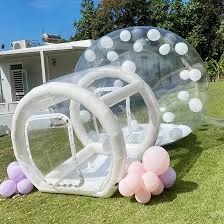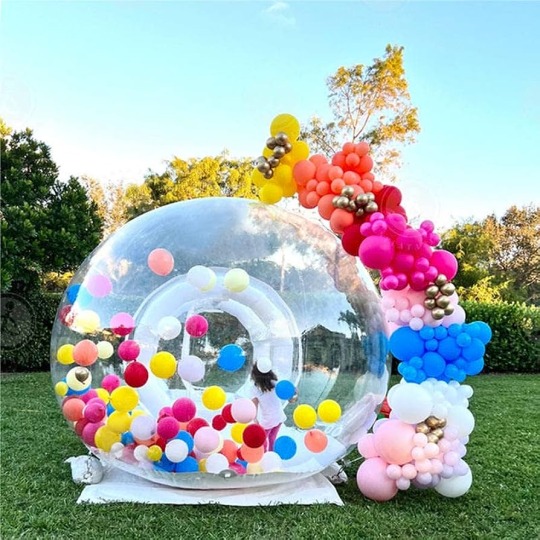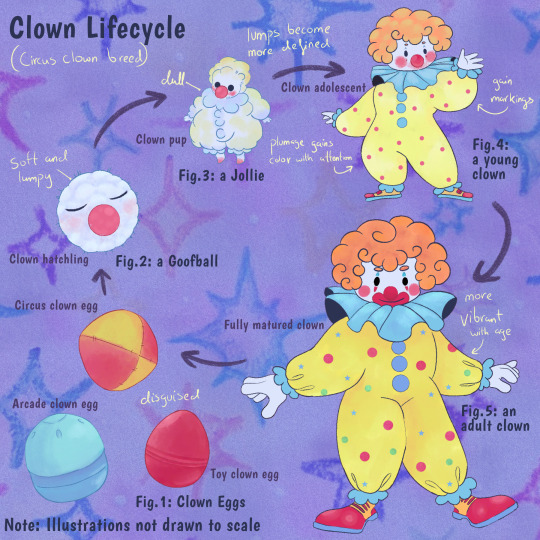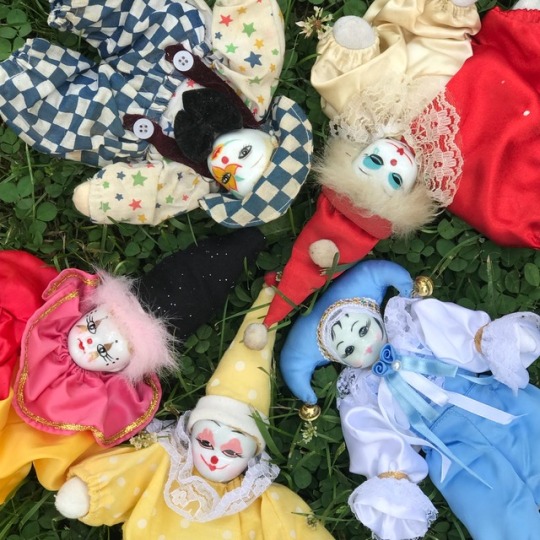I wanna adopt a Clown so bad, main blog @royalcourtjesterly
Don't wanna be here? Send us removal request.
Text
Public service announcement!
If you see a service/emotional support clown in public, DO NOT INTERACT!! I’m tired of hearing story after story from my friends about how someone was distracting their service clown. If they have a vest on they’re working, end of story! Don’t try to get them to honk, show you a magic trick, and especially don’t try to feed them. Just pretend like they’re not there. Thank you
1K notes
·
View notes
Text
Senior clown diet


Once your clown has started getting older you’ll notice that they will have less of an interest in their normal food. Older clowns will start getting weaker jaws and some clown breeds will even have teeth fall out. Normally this happens to your average hobo and circus clowns. That’s why jello can be perfect diet for your older clowns. It is very important to change their diet to better suit their new needs. Jello is fantastic because it’s gentle on their teeth and jaws. Popcorn and rats can hurt their fragile teeth easily and jello provides all of the nutritional value necessary for your clown.
1K notes
·
View notes
Text

Polka Pox is a viral infection common among clowns regardless of breed ancestry, characterized by colorful polka-dot rashes on the skin. Symptoms include fever, itching, and fatigue. Ensure your pet clown is up to date on their vaccinations!
715 notes
·
View notes
Text
Improper clown housing


Enclosures like these do not provide the same comfort and safety that bouncy castles, and bouncy houses, and ball pits provide. Getting a bubble like this for your clown because “you like the aesthetic” is cruel. The see through bubble will make your clown feel improperly hidden or and safe which can lead to severe stress and panic attacks. This bubble will provide little to no enrichment for you clown. It can also be a hazard, some clown breeds have poor eyesight similar to how birds can’t see glass and have poor depth perception. This is why having brightly colored and padded walls such as in a bouncy house are crucial for the safety of your clowns. Clowns deserve a place to feel comfortable and safe. These bubble houses should not be used as a replacement for a bouncy house or ball pit. Sadly I have seen them be marketed as a two in one replacement for both. New clown owners need to be aware of this and steer clear of these.
2K notes
·
View notes
Text

"Featured here is the lifecycle of a clown, specifically illustrated through a Circus Clown. Although individual characteristics may vary, such as the shape and color of the camouflaged egg, the size and texture of the Goofball, and the emerging colors of the Jollie, all clowns undergo similar developmental stages. These stages encompass a diverse range of traits exhibited by young and adult clowns, influenced by their respective breeds or subspecies."
1K notes
·
View notes
Text
Y'all do know that Jesters and Harlequins are . . . different, right?
Harlequins may wear similar clothing to a Jester, but there are a lot of differences.
Firstly, Harlequins are completely mute (similar to a mime), whereas Jesters are extremely noisy, and tend to make lewd jokes.
In addition, their diets and preferred performance areas are seperate. Jesters prefer traditional European and Middle Eastern treats (think dates and bread), while Harlequins are primarily carnivorous. Jesters prefer to perform in taverns and ballrooms, while Harlequins enjoy forests and large, cluttered rooms.
620 notes
·
View notes
Text
Gooooood morning everyone! And happy clown week!

13K notes
·
View notes
Text

[Image ID: A blurry circus tent on a colorful background with white text that reads "Clown fact #29 / Jesters are typically smaller than most clowns! / @thecoulrologist". End ID]
This allows them to perform funnier tricks for the king!
65 notes
·
View notes
Note
Hello, I was scared I wouldn't find someone who was still active in the clown care community! I'm looking for breed recommdation based on my circumstances written below! If you are willing to of course! No pressure!
I live in a medium-small appartment.
I spend my time mostly inside.
Has to be compatible with other pets.(cat and dog)
I work at night so I sleep a lot during the day. I can still give 4-5 hours of playtime.
I want one that's cuddly and can help cheering me up.
I tend to be low on energy but I get huge outburst of energy sometimes.
I'm ready to make tons of research and to change my lifestyle to accommodate my clown!
Well I can recommend a few varieties
One that I think could work is Teacups. They're little clowns that can fit into small cups and mugs. Teacups are heavily recommended for apartment living and low enrichment environments. However, they're not very good around cats or dogs and they're obviously not good cuddlers.
Scares are also a good recommendation. They need a good bit more space but they're nocturnal clowns who can co exist with other animals and also need only a bit of enrichment like teacups. However, again, poor cuddlers and fluctuating energy levels will confuse them.
So you know which variety I recommend? They're a bit of a 'sleeper' breed but...
Blanket clowns! They're amazing clowns for your situation. They love cuddling, they're not too active, they'll enjoy any cats or dogs, they'll make an excellent candidate to add to your home. Just be sure to keep their membranes well cared for and you'll have a new best friend
70 notes
·
View notes
Text
Suncatcher glass clowns info (long post)
Temperament:
Suncatcher glass clowns are not a beginner breed. They can be difficult to care for and are best suited for those with experience in fragile teacup breeds, such as porcelain. They can shatter and crack, and while they can be put back together, scars and cracks will likely stay. They are generally non aggressive, but they can be energetic and mischievous at times. They use their flat bodies to play pranks on their owner, such as hiding inside the wall. Although they often don't think before hand how to get themselves out of a hiding spot. They are very playful and enjoy to run, jump, and climb, despite the fact they could be seriously injured by not being careful. Gentle handling is recommended. They are often fearless and brave, and will try and defend you like a scare clown would. They aren't really aware of their own fragility, even after surviving a breaking/cracking. Tent Details:
Suncatcher glass clowns enjoy many surfaces amd items to climb and play on. Many soft landing pads are recommended, as they often don't realize the consequences for not sticking the landing before its too late and they break. They enjoy making art, but traditional drawing can be difficult due to limited mobility, non toxic paint is a good option. They enjoy climbing surfaces, such as ropes and chains. They love sunny windows, and placing a rope or platform in front of one Is a good idea, as they love to be In front of it and cast rainbows throughout the room. Completely clear clowns may have trouble casting as vibrant rainbows their peers, which can cause distress at times. Muted, and neutral colored toys and tent are best, as Suncatcher glass clowns love being the brightest colored thing in the room. Even if your house is brightly colored, a dull secluded area where they can be the star of the show is still great. Be careful of crevices they can become stuck in, or dangerous corners and falls. Baby proofing is often essential to making sure they don't shatter themselves or get stuck under a table.Social Interaction
Suncatcher glass clowns are a very social breed. They often form family groups, and are very friendly with outsiders. Porcelain and other Suncatcher glass clowns make the best playmates, as they less likely to cause an accidental shattering. Though larger breeds can also interact with supervision, and if they are taught about being careful and gentle, testing with an uncooked egg can help see if they are ready yet. Suncatcher glass clowns often have large clutches of up to 70 small eggs, and will often try to provide care for every egg, even if it is way too much for them to handle. They are unlikely to abandon nests, offspring, and those they consider in their "group" willingly, even if they are sick, injured, or deceased.
Food:
Suncatcher glass clowns enjoy a wide variety of foods. They eat things closer to their wild counterparts would than most clowns. They enjoy vegetables, fruits, nuts, grasses, and even some mushrooms, though you should look up if a new food is toxic before feeding it to them. They also enjoy popcorn and various sweets, although baked goods can give them intestinal issues. They are scavengers and foragers, and will eat meat and protein, but they aren't naturally hunters. They typically only hunt live prey in desperation, and this is often only observed in ferals. Genetics: Glass suncatcher clowns are more likely to hatch with missing, malformed, or non working limbs than other breeds. They can also be more prone to sight and hearing issues. The stained gene is recessive and causes translucent color. It often comes with a fragility gene, fragility often disappears a few weeks after hatching, but can persist into adult life. They have dominant trait for bright colors and plumage, recessive for pastels. The rarest type is clear and colorless, but breeding these requires a mutation that can sometimes occur when double stained gene is present. This means they often have health issues in life. They also have a recessive trait for facelessness. They habe all the functions of a faced clown, their face is just not visable. Though a mouth that isn't visible when closed has been observed opening when its time to eat. Suncatcher glass clowns are often mistreated in the breeding industry and pet trade, and can have a host of health issues. Glass suncatcher clowns have been bred to produce very large clutches. They're also valuable in the pet trade, especially if they are a carrier for stained gene or have nice colors, generally pastels are harder to produce and considered more valuable than vibrant colored clowns. Unethical Breeders often dispose of "undesirable" chucklets who can still live a long healthy life, such as those with health issues or sometimes even poor coloration. Overbreeding is also an issue, as parents that produce good offspring are bred an unhealthy amount of times. Another thing is that, like most teacup breeds, Suncatcher glass clowns don't produce much milk. This is not an issue when most teacup clowns typically only have 1-2 eggs per clutch. But with large clutches, glass suncatcher clowns can't feed their chucklets by themselves. Another thing is that Suncatcher Glass clowns are often reluctant breeders, and their eggs often taken away after being laid. This can cause distress, as the clown misses its eggs. . Taxonomy: Suncatcher Glass clowns aren't a common breed, and can be expensive from a breeder. They used to be larger, more earth toned, and with much more powerful rainbow sunbeams. They were domesticated in victorian times, as having a beautiful little glass clown to cast rainbows and do amusing tricks for guests became quite fashionable among upper class society. The rainbows casted by modern clowns are mostly just for show, but pre domesticated clowns used theirs to temporarily blind predators as a distraction to get away, similar to squid ink.
52 notes
·
View notes
Text
Discussing Pierrot/Birthday mixes
Recently, I’ve seen many clown owners who are beginners adopting “pierrot/birthday” crossbreeds. But, from further investigation of these clowns I’ve noticed that these aren’t Pierrot/birthday clowns, but delicate Starfrost clowns.
Most people are unfamiliar with this breed, because it used to be very uncommon. Starfrost clowns were usually used for “the dance of the stars”, an old common holiday celebrated in December for showings of a new year and a brighter future. These clowns would mimic the stars in a dance form that looked as though these clowns were shooting stars. But since this holiday has died down, so has the need for starfrost clowns.
If I’m being honest, I thought this breed had fully died off. But I’ve been seeing so many more breeds of them which is super exciting! These breeds normally have minimal designs on their face, but the designs they do have are beautifully drawn stars that look like they’re almost shining. There isn’t an exact color palette for them, but their colors mostly range from all different sorts of pastels. These clowns almost resemble ballet dolls, from their delicate and elegant features. Their dress mostly resembles ballet wear, and beautiful long flown dress wear. These are definitely the more fancy types of clowns and even their personalities are like this!
These clowns are very quiet, a lot like mimes and Pierrots. They normally jingle and almost sound like they’re twinkling. They’re often really small, ranging from 2-4 feet tall. They’re very calm and docile, but that doesn’t mean they’re easy to manage. Their enrichment can be extremely hard to find, and if I’m being honest I’m not fully sure what all of their enrichment toys are. Their taste is also really refined. They enjoy teaparties and cookies, and adore cupcakes and hot chocolate from what I’ve heard. Basically anything that you’d classify as “winter food” will work. They just really enjoy desserts and especially if they’re star themed. They also need lots of space to dance around and play, and an area with lots of soft colors with stars will make them feel at home. AND REMEMBER! These types of clowns NEED a cold environment! If you live anywhere even remotely hot, I’d suggest not getting one of these guys. On the flip side, if you live in a cold or rainy environment I’d highly suggest giving them a nice loving home!
In my opinion, if your a beginner clown owner I don’t think you should get one of these guys. From what I’ve heard they can be a very hard clown to take care of and keep happy. And I’ve also seen clown owners with a lot of variety in other clowns get one of these guys and I would HIGHLY SAY NO TO THAT!! Starfrost clowns are very bad with other clowns, and can be very dangerous and can lock down if with too many different breeds. They need to have other clowns that are quieter, such as scare, pierott, mimes, sad clowns and other starfrosts. If you have breeds such as rodeo, party, birthday ect, then it could make them go into hiding or even make them go into a depression. Please make sure to have a good mix of quiet clowns for starfrosts!
I hope this made you consider getting some starfrosts, and giving them a nice lovely home! Have fun clowning around everyone :o)
96 notes
·
View notes
Text
Talked to my sister about if juggalos are considered a species of clown and what she came up with was
"Are juggalos clown furries?" And i NEED an answer
61 notes
·
View notes
Text
Excellent! I cannot care for a scare clown, as I cannot handle being scared all the well, but I definitely will be getting a Sad clown as soon as I can! I’m looking into breeders and have narrowed it down to a few good ones, I hope to be successful soon!
Hey Clownblr I’ve been looking into getting myself my very first pet clown, and I have two questions:
1) Are Sad Clowns good beginner Clowns? I keep trying to find information on them but it’s a bit sparse
2) I have a pet Plague Doctor already, do Clowns and Plague Doctors get along well?
Any/All advice appreciated!
77 notes
·
View notes
Text
This week’s spotlight: Sad clowns!

Sad clowns (From the Genus Dolorem) are very popular pets world wide, and for good reason! With a subdued temperament, minimal healthcare concerns and a standard diet, they are a go to breed for many owners.
A common misconception is that Sad clowns are, well, sad. This is incorrect! Many of the mannerisms held by sad clowns which are perceived to be signs of sadness, i.e crying, sad honking, failing tricks, sad cuddling, are signs of a happy, healthy clown! If there is an issue with your Sad clown, they will usually be a bit more manic in their performances and behaviour. For example, whilst a healthy Sad clown may juggle bowling pins and drop them, an ill sad clown may juggle them and end up throwing them in frustration. Another example is that A Healthy sad clown may hold a cream pie and then trip, face planting into the pie, an unhealthy sad clown will just directly pie itself in the face.

A sad clown’s tricks are almost always a failure, and they gain great joy out of appearing to be incompetent. They do great both in a troupe and as a solitary pet, and can make great comfort clowns. Some breeds that they get on extremely well with include:
Juggler clowns
Kreepus clowns
Contortionist Clowns
Party Clowns
Pierrots
Hobo clowns
However, Sad clowns do not get on well with Harlequins! Sad clowns thrive off of mimicking other clowns tricks and failing at them, and they find it hard to mimic Harlequins. Due to this they can become aggressive.
Sad clowns have few health issues, but keep an eye out for paint smearing and decolorisation of facial markings, which are a sign of stress. Some breeds can be predisposed to blindness as well, so check with your adoption agency/vet for any issues in lineage.

A Sad clown’s diet is similar to many other clowns. Cotton candy, Seltzer water, cream pies, and funnel cake are all staples. Don’t be concerned if your clown picks at it’s food, or makes a mess and appears upset. Again, all apart of the normal behaviour of a healthy Sad clown.
Sad clowns love most props; juggling balls, unicycles, cream pies, However keep the away from acrobatic props such as tight ropes and contortion boxes, as their instinct to fail at these tricks can cause injury.
All in all, this breed is an excellent addition to any home, and can be bred with most other breeds of clowns.
Friendliness: 4/5
Health: 4/5
Grooming: 3/5
Costs: 4/5
222 notes
·
View notes


